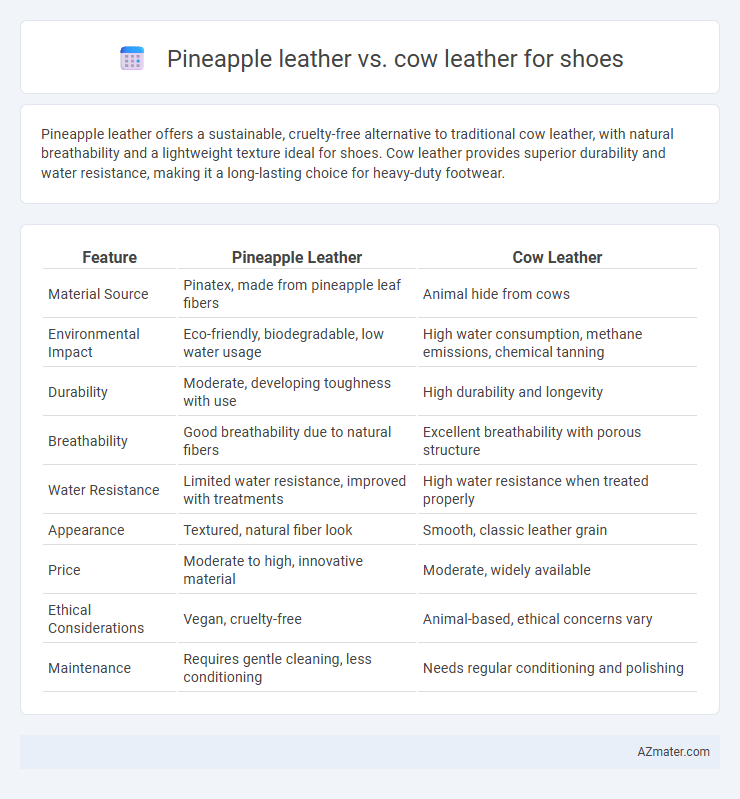Pineapple leather offers a sustainable, cruelty-free alternative to traditional cow leather, with natural breathability and a lightweight texture ideal for shoes. Cow leather provides superior durability and water resistance, making it a long-lasting choice for heavy-duty footwear.
Table of Comparison
| Feature | Pineapple Leather | Cow Leather |
|---|---|---|
| Material Source | Pinatex, made from pineapple leaf fibers | Animal hide from cows |
| Environmental Impact | Eco-friendly, biodegradable, low water usage | High water consumption, methane emissions, chemical tanning |
| Durability | Moderate, developing toughness with use | High durability and longevity |
| Breathability | Good breathability due to natural fibers | Excellent breathability with porous structure |
| Water Resistance | Limited water resistance, improved with treatments | High water resistance when treated properly |
| Appearance | Textured, natural fiber look | Smooth, classic leather grain |
| Price | Moderate to high, innovative material | Moderate, widely available |
| Ethical Considerations | Vegan, cruelty-free | Animal-based, ethical concerns vary |
| Maintenance | Requires gentle cleaning, less conditioning | Needs regular conditioning and polishing |
Introduction to Pineapple Leather and Cow Leather
Pineapple leather, also known as Pinatex, is an innovative sustainable material made from pineapple leaf fibers, offering an eco-friendly alternative to traditional leather. Cow leather, derived from cattle hides, is renowned for its durability, breathability, and classic texture, widely used in high-quality footwear. Comparing pineapple leather and cow leather reveals differences in environmental impact, texture, and maintenance, with pineapple leather emphasizing sustainability and cow leather excelling in strength and longevity.
Environmental Impact: Pineapple Leather vs Cow Leather
Pineapple leather, derived from sustainable pineapple leaf fibers, significantly reduces environmental impact compared to traditional cow leather by minimizing water consumption, greenhouse gas emissions, and deforestation. Cow leather production involves resource-intensive processes, including high water usage, methane emissions from livestock, and chemical tanning methods that contribute to soil and water pollution. Choosing pineapple leather for shoes supports eco-friendly fashion with a lower carbon footprint and promotes the use of agricultural waste materials.
Durability and Performance Comparison
Pineapple leather, made from Pinatex fibers, offers a sustainable alternative to traditional cow leather but generally exhibits lower abrasion resistance and tensile strength, impacting long-term durability in high-stress shoe applications. Cow leather is renowned for its superior durability, flexibility, and natural water resistance, making it ideal for performance footwear that requires longevity and structural support. While pineapple leather excels in eco-friendliness and breathability, cow leather maintains a performance advantage in wear resistance and overall shoe lifespan.
Comfort and Breathability in Shoes
Pineapple leather, derived from natural fibers of pineapple leaves, offers superior breathability compared to traditional cow leather, enhancing airflow and reducing foot moisture during extended wear. This plant-based material is lightweight and flexible, contributing to increased comfort by adapting to foot movements more easily than the typically denser cow leather. Cow leather shoes provide durability and a classic fit but may retain heat and moisture, making pineapple leather an innovative alternative for breathable, comfortable footwear.
Aesthetic Qualities and Design Flexibility
Pineapple leather offers a unique, textured surface with natural variations that enhance the aesthetic appeal of shoes, providing an eco-friendly option with a modern, organic look. Unlike cow leather, which delivers a classic, smooth finish and ages with a distinctive patina, pineapple leather allows for more versatile dyeing and embossing techniques, enabling innovative and bold design creations. Designers often prefer pineapple leather for its sustainable origin and ability to support contemporary, fashion-forward styles without compromising visual richness or tactile interest.
Cost Analysis: Production and Retail
Pineapple leather production costs are generally higher due to the labor-intensive extraction and processing of Pinatex fibers, while cow leather benefits from established, large-scale tanning industries that reduce expenses. Retail prices for pineapple leather shoes often reflect their sustainable appeal and handcrafted nature, positioning them as premium products despite smaller production runs. Cow leather shoes typically have a broader price range influenced by grade and finish, with mass production enabling more competitive pricing in mainstream markets.
Ethical Considerations and Animal Welfare
Pineapple leather, made from sustainable pineapple leaf fibers, offers an ethical alternative to traditional cow leather by eliminating animal cruelty and reducing reliance on livestock farming, which is associated with significant environmental degradation. Cow leather production involves raising and slaughtering animals, raising serious animal welfare concerns and contributing to greenhouse gas emissions and deforestation. Opting for pineapple leather supports cruelty-free fashion and promotes a low-impact, plant-based material that aligns with ethical consumer values.
Maintenance and Care Requirements
Pineapple leather, derived from sustainable Pinatex fibers, requires gentle cleaning with a damp cloth and mild soap, avoiding prolonged exposure to water to maintain its texture and durability. Cow leather demands regular conditioning with leather-specific products to prevent drying and cracking, along with protection from excessive moisture and direct sunlight. Both materials benefit from proper storage in cool, dry environments, but pineapple leather typically offers easier maintenance due to its naturally resistant and breathable properties.
Market Availability and Consumer Trends
Pineapple leather, derived from Pinatex, is gaining traction in sustainable fashion markets but remains less available than traditional cow leather, which dominates global shoe manufacturing due to established supply chains and durability. Consumer trends show increasing demand for eco-friendly materials, driving niche growth in pineapple leather shoes, especially among vegan and environmentally conscious buyers. Market availability of pineapple leather is expanding gradually but still limited compared to the widespread accessibility and variety of cow leather footwear options.
Conclusion: Choosing Between Pineapple and Cow Leather for Shoes
Pineapple leather offers a sustainable and cruelty-free alternative to traditional cow leather, making it an ideal choice for eco-conscious consumers seeking stylish, durable shoes. Cow leather excels in durability, breathability, and water resistance, providing a long-lasting option favored for heavy-duty and formal footwear. Selecting between pineapple and cow leather depends on priorities such as environmental impact, animal ethics, durability needs, and aesthetic preferences for shoe material.

Infographic: Pineapple leather vs Cow leather for Shoe
 azmater.com
azmater.com